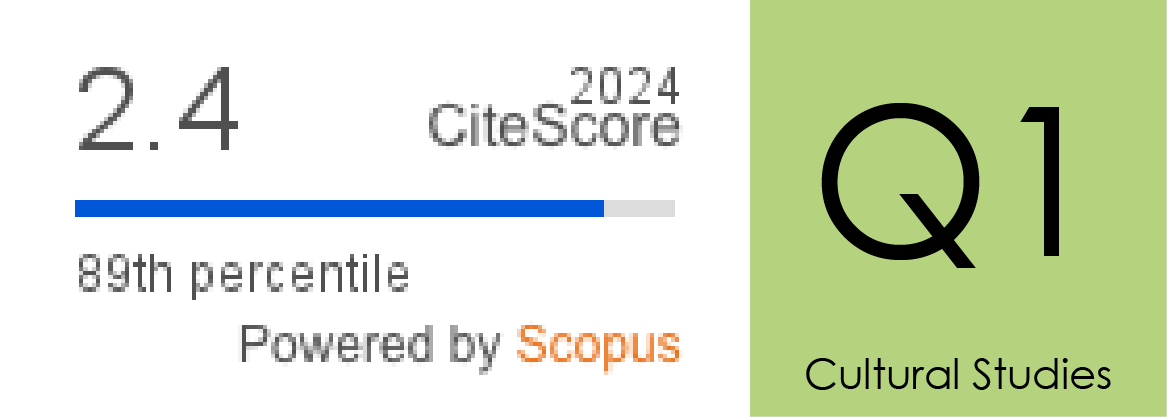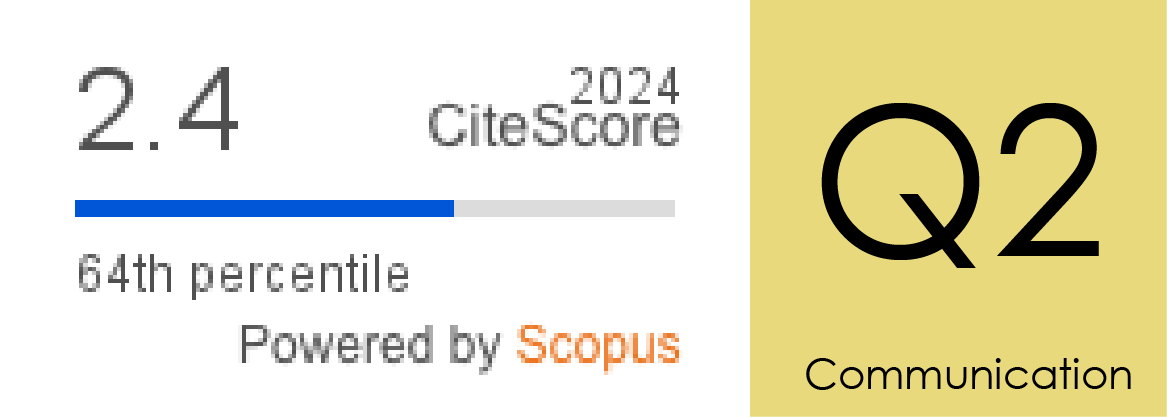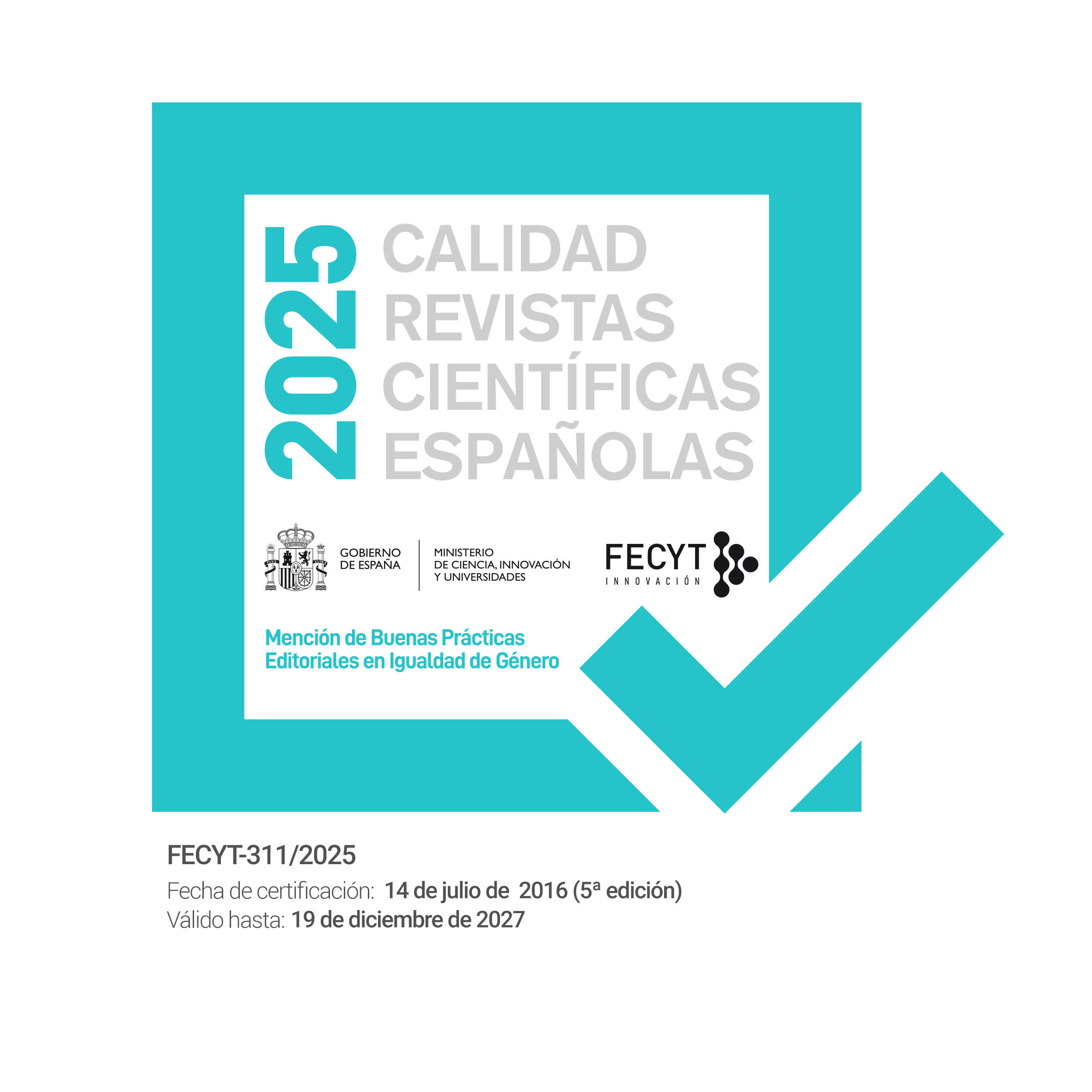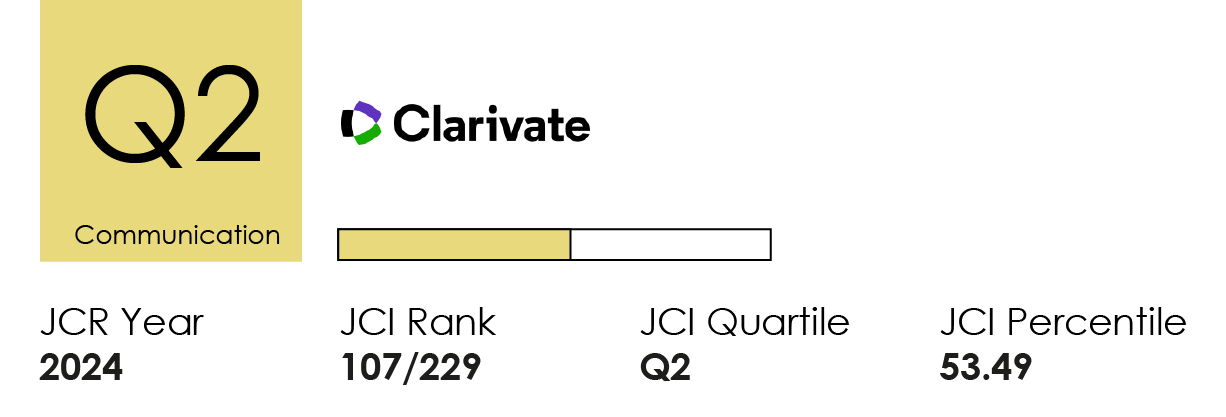Seis años de investigaciones de crisis públicas en social media. Análisis sistemático de las principales aportaciones y guía de recomendaciones para estudios futuros
DOI:
https://doi.org/10.14198/MEDCOM.25983Palabras clave:
Comunicación de crisis, redes sociales, gestión de crisis, comunicación gubernamental, scoping review, revisión sistemáticaResumen
La investigación sobre el uso del social media en la gestión de crisis públicas ha crecido sustancialmente en los últimos años. Sin embargo, generalmente los estudios suelen concentrarse en el análisis de crisis que son producto de accidentes, desastres naturales y emergencias sanitarias, con poca visibilidad sobre crisis asociadas a conflictos de índole social o política. El objetivo de este trabajo es evaluar el estado de la investigación que existe sobre el uso de redes sociales en la comunicación de crisis de gobiernos e instituciones. Por medio de un scoping review de la investigación sobre este tema del 15 de mayo de 2017 al 14 de mayo de 2023, se han identificado factores como las teorías, los tipos de crisis, las plataformas de redes sociales y el ámbito institucional que reciben mayor interés investigativo. Luego, se sintetizan las principales recomendaciones que propone la academia para el uso del social media en la gestión de crisis. Con miras a la comunicación de crisis de los próximos años, se destaca la necesidad de desarrollar más investigación sobre las crisis políticas, considerar factores como el contexto y la globalización, incorporar nuevas metodologías y expandir el análisis a otras plataformas.
Citas
Adegbola, O., & Okunyole, O. (2022). A tale of two kidnappings: Government response to Chibok & Dapchi attacks in Nigeria. Public Relations Review, 48. https://dx.doi.org/10.1016/j.pubrev.2022.102248
Arora, S., Debesay, J., & Eslen-Ziya, H. (2022). Persuasive narrative during the COVID-19 pandemic: Norwegian Prime Minister Erna Solberg’s posts on Facebook. Humanities and Social Sciences Communications, 9. https://dx.doi.org/10.1057/s41599-022-01051-5
Auer, C. (2016). Conceptualizing political crisis and the role of public diplomacy in crisis communication research. In A. Schwarz (Ed), The Handbook of International Crisis Communication Research (pp. 119-132). John Wiley & Sons.
Austin, L. & Jin, Y. (2016). Social media and crisis communication. Explicating the Social-mediated crisis communication model. In A. Dudo & L. Kahlor (Eds.), Strategic Communication. New agendas in communication (pp. 163–186). Routledge.
Benoit, W. (1997). Image repair discourse and crisis communication. Public Relations Review, 23(2), 177-186. https://dx.doi.org/10.1016/S0363-8111(97)90023-0
Boin, A. (2018). The transboundary crisis: why we are unprepared and the road ahead. Journal of Contingencies and Crisis Management, 27. https://dx.doi.org/10.1111/1468-5973.12241
Boin, A., Hart, P., & McConnell, A. (2008). Crisis exploitation: Political and policy impacts of framing contests. Journal of European Public Policy, 16(1). https://dx.doi.org/10.1080/13501760802453221
Boin, A., Hart. P., & Kuipers, S. (2017). The Crisis approach. In H. Rodríguez (Ed.), Handbook of Disaster Research. Handbooks of Sociology and Social Research (pp. 23-38). Springer.
Boin, A., Ekengren, M., & Rhinard, M. (2020). Hiding in plain sight: Conceptualizing the creeping crisis. Risk, Hazards & Crisis in Public Policy, 11(2). https://dx.doi.org/10.1002/rhc3.12193
Bruns, A. (2014). Crisis communication. In S. Turnbull, & S. Cunningham (Eds.), The media and communications in Australia (pp. 351-355). Allen and Unwin.
Bruns, A., & Burgess, J. (2014). Crisis communication in natural disasters: The Queensland floods and Christchurch earthquakes. In A. Bruns, M. Mahrt, K.Weller, J. Burgess, & C. Puschmann (Eds.), Twitter and society (pp. 373-384). Peter Lang Publishing.
Bukar, U. A., Jabar, M. A., Sidi, F., Nor, R. N. H. B., Abdullah, S., & Othman, M. (2020). Crisis informatics in the context of social media crisis communication: Theoretical models, taxonomy, and open issues. IEEE Access, 8. https://dx.doi.org/10.1109/ACCESS.2020.3030184
Cameron, G., Pang, A., & Jin, Y. (2007). Contingency theory: Strategic management of conflict in public relations. In T. Hansen-Horn, & B. Neff (Eds.), Public relations: From theory to practice (pp. 134–157). Pearson Allyn & Bacon.
Calloway, E. E., Nugent, N.B., Stern, K.L., Mueller, A., & Yaroch, A.L. (2022). Lessons learned from the 2019 Nebraska Floods: Implications for emergency management, mass care, and food security. International Journal of Environmental Research and Public Health, 19(18). https://dx.doi.org/10.3390/ijerph191811345
Cannaerts, N. (2020). Crisis communication in public emergencies: multistakeholders’ perspectives. International Journal of Emergency Services, 10(1). https://dx.doi.org/10.1108/IJES-07-2019-0038
Chadwick, A. (2019). The new crisis of public communication: Challenges and opportunities for future research on digital media and politics. Online Civic Culture Centre. https://bitly.ws/38ZG9
Cheng, Y. (2016). How social media is changing crisis communication strategies: Evidence from the updated literature. Journal Of Contingencies and Crisis Management, 2(4). https://dx.doi.org/10.1111/1468-5973.12130
Cheng, Y., Wang, Y., & Kong, Y. (2022). The state of social-mediated crisis communication research through the lens of global scholars: an updated assessment. Public Relations Review, 48(2). https://dx.doi.org/10.1016/j.pubrev.2022.102172
Codina, L. (1 de septiembre de 2021). Scoping reviews: características, frameworks principales y uso en trabajos académicos. Lluiscodina.com https://bitly.ws/VNaw
Contri, M., Fissi, S., & Gori, E. (2023). Can Facebook really be a tool for supporting citizen engagement during emergencies? Journal of Public Affairs, 23(3). https://dx.doi.org/10.1002/pa.2857
Coombs, W. T. (2007). Protecting organization reputations during a crisis: The development and application of situational crisis communication theory. Corporate Reputation Review, 10(3). https://dx.doi.org/10.1057/palgrave.crr.1550049
Coombs, W.T. (2010). Crisis Communication and its allied fields. In W. Coombs, & J. Holladay (Ed), The Handbook of Crisis Communication (pp. 54-64). Wiley Blackwell.
Coombs, W.T., & Holladay, S.J. (2023). The Handbook of Crisis Communication. Willey Blackwell.
Davis, A. (2019). Political communication: A new introduction for crisis times. John Wiley & Sons.
Deng, Q., Gao, Y., Wang, C., & Zhang, H. (2020). Detecting information requirements for crisis communication from social media data: An interactive topic modeling approach. International Journal of Disaster Risk Reduction, 50. https://dx.doi.org/10.1016/j.ijdrr.2020.101692
Dong, C., Zheng, Q., & Morehouse, J. (2023). What do we know about government public relations (GPR)? A systematic review of GPR in public relations literature. Public Relations Review, 49. https://dx.doi.org/10.1016/j.pubrev.2022.102284
Eriksson, M. (2018). Lessons for crisis communications on social media: A systematic review of what research tells the practice. International Journal of Strategic Communication, 12(5). https://dx.doi.org/10.1080/1553118X.2018.1510405
Eriksson, M., & Olsson, E. K. (2016). Facebook and Twitter in crisis communication: A comparative study of crisis communication professionals and citizens. Journal of Contingencies and Crisis Management, 24(4). https://dx.doi.org/10.1111/1468-5973.12116
Elsamni, A. (17 de febrero de 2018). Social media applications in crisis management of natural disasters: Lessons for the Arab region. Arab Media & Society. https://bitly.ws/VNjE
Falkheimer, J., & Heide, M. (2006). Multicultural crisis communication: Towards a social constructionist perspective. Journal of Contingencies and Crisis Management, 14(4). https://dx.doi.org/10.1111/j.1468-5973.2006.00494.x
Ferra, I., & Nguyen, D. (2017). #Migrantcrisis: “tagging” the European migration crisis on Twitter. Journal of Communication Management, 21(4). https://dx.doi.org/10.1108/JCOM-02-2017-0026
Frandsen, F., & Johansen, W. (2020a). A Brief history of crisis management and crisis communication. In F. Frandsen, & W. Johansen (Eds), Crisis Communication (pp. 17-58). De Gruyter Mouton.
Frandsen, F., & Johansen, W. (2020b). Reframing the field: Public crisis management, political crisis management, corporate crisis management. In F. Frandsen, & W. Johansen (Eds), Crisis Communication (pp. 59-104). De Gruyter Mouton.
Fraustino, J. D., Liu, B.F., & Jin, Y. (2012). Social media use during disasters: A review of the knowledge base and gaps. Final Report to Human Factors/Behavioral Sciences Division, Science and Technology Directorate, U.S. Department of Homeland Security. MD: START.
Fraustino, J. D., & Liu, B.F. (2017). Toward more audience-oriented approaches to crisis communication and social media research. In L. Austin, & Y. Jin (Eds), Social Media and Crisis Communication (pp.129-140). Routledge.
García-García, S., & Rodríguez-Díaz, R. (2023). Official information on Twitter during the pandemic in Spain. Societies, 13(91). https://dx.doi.org/10.3390/soc13040091
Gilpin, D., & Murphin, P. (2010). Implications of complexity for public relations: Beyond crisis. In R. L. Heath (Ed), Handbook of Public Relations (pp.150-178). Sage.
Gundel, S. (2005). Towards a New Typology of Crises. Journal of Contingencies and Crisis Management. 13(3). https://dx.doi.org/10.1111/j.1468-5973.2005.00465.x
Karl Grebe, S. (2012). Things can get worse. How mismanagement of a crisis response strategy can cause a secondary or double crisis: The example of the AWB corporate scandal. Corporate Communications: An International Journal, 18(1). https://dx.doi.org/10.1108/13563281311294137
Kim, S. (2022). Dimensions of effective government pandemic‐crisis communication in the context of COVID‐19: A public‐centric perspective. Journal of Contingencies and Crisis Management, 31(3), 320-337. https://dx.doi.org/10.1111/1468-5973.12441
Hagen, L., Scharf, R., & Keller, T. (2020). Social media use for crisis and emergency risk communications during the Zika health crisis. Digital Government: Research and Practice, 13, 2-21. https://dx.doi.org/10.1145/3372021
Hämpke, J., Röseler, S., & Thielsch, M. (2022). Is being funny a useful policy? How local governments’ humorous crisis response strategies and crisis responsibilities influence trust, emotions, and behavioral intentions. International Journal of Disaster Risk Science, 13. https://dx.doi.org/10.1007/s13753-022-00436-z
Ihlen, Ø., & Levenshus, A. (2017). Digital dialogue: Crisis communication in social media. In L. Austin & Y. Jin (Eds.), Social media and crisis communication (pp. 389-400). Routledge.
Imran, M., Castillo, C., Díaz, F., & Vieweg, S. (2018). Processing social media messages in mass emergency: Survey summary. In WWW '18: Companion Proceedings of the The Web Conference, 2018 (pp. 507–511). https://dx.doi.org/10.1145/3184558.3186242
Islm, T., Meng, H., Pitafi, A.H., Zafar, A.U., Sheikh, Z., Mubarik, M.S., & Liang, X. (2021). Why do citizens engage in government social media accounts during COVID-19 pandemic? A comparative study. Telematics and Informatics, 62. https://dx.doi.org/10.1016/j.tele.2021.101619
Jaques, T. (2007). Issue management and crisis management: an integrated, non-linear, relational construct. Public Relations Review, 33. https://dx.doi.org/10.1016/j.pubrev.2007.02.001
Jin, Y., & Liu, B. F. (2010). The blog-mediated crisis communication model: Recommendations for responding to influential external blogs. Journal of Public Relations Research, 22(4). https://dx.doi.org/10.1080/10627261003801420
Johansen, W., & Frandsen, F. (2010). Crisis communication, complexity, and the cartoon affair: A case study. In W.T. Coombs y S. Holladay (Eds), The Handbook of crisis communication (pp.425-448). Blackwell Publishing.
Kent, M. L., & Taylor, M. (2002). Toward a dialogic theory of public relations. Public Relations Review, 28. https://dx.doi.org/10.1016/S0363-8111(02)00108-X
Knox, C.C. (2023). Local emergency management’s use of social media during disasters: a case study of Hurricane Irma. Disasters, 47(2). https://dx.doi.org/10.1111/disa.12544
Lerbinger, O. (2012). The Crisis manager. Facing disasters, conflicts and failures. Taylor & Francis.
Li, Y., Chandra, Y., & Fan, Y. (2021). Unpacking government social media messaging strategies during the COVID‐19 pandemic in China. Policy and Internet, 14. https://dx.doi.org/10.1002/poi3.282
Lin, X., Spence, P., Sellnow, T., & Lachlan, K. (2016). Crisis communication, learning and responding best practices in social media. Computers in Human Behavior, 65. https://dx.doi.org/10.1016/j.chb.2016.05.080
Liu, B.F., Austin, L., & Yin, J. (2011). How publics respond to crisis communication strategies: The interplay of information form and source. Public Relations Review, 37. https://dx.doi.org/10.1016/j.pubrev.2011.08.004
Liu, W., Lai, C. & Xu, W. (2018). Tweeting about emergency: A semantic network analysis of government organizations’ social media messaging during Hurricane Harvey. Public Relations Review, 44(5). https://dx.doi.org/10.1016/j.pubrev.2018.10.009
Loiti-Rodríguez, S., Genaut-Arratibel, A., & Cantalapiedra-González, M. J. (2021). Crisis communication in audiovisual format: information from Spain’s National Health System on YouTube in 2020. Profesional de la información, 30(4). https://dx.doi.org/10.3145/epi.2021.jul.16
Luo, L., Duan, S., Shang, S., & Lyu, W. (2021). Understanding citizen engagement and concerns about the COVID-19 pandemic in China: a thematic analysis of government social media. Aslib Journal of Information Management, 73(6). https://dx.doi.org/10.1108/AJIM-11-2020-0377
Maal, M., & Wilson-North, M. (2019), Social media in crisis communication – the “do’s” and “don’ts”. International Journal of Disaster Resilience in the Built Environment, 10(5). https://dx.doi.org/10.1108/IJDRBE-06-2014-0044
Malik, A. Khan, M., & Quan-Hasse, A. (2021). Public health agencies outreach through Instagram during the COVID-19 pandemic: Crisis and Emergency Risk Communication perspective. International Journal of Disaster Risk Reduction, 61. https://dx.doi.org/10.1016/j.ijdrr.2021.102346
Mitcham, D., Taylor, M., & Harris, C. (2021). Utilizing social media for information dispersal during local disasters: The Communication Hub Framework for local emergency management. International Journal of Environmental Research and Public Health, 18. https://dx.doi.org/10.3390/ijerph182010784
Naidoo, K., & Wyk, J. (2019). Protocol for a scoping review of age-related health conditions among geriatric populations in sub-Saharan Africa. Systematic Reviews, 8(1), 133. https://dx.doi.org/10.1186/s13643-019-1055-z
Olsson, E. (2014). Crisis communication in public organizations: dimensions of crisis communication revisited. Journal of Contingencies and Crisis Management, 22(2), 113-125. https://dx.doi.org/10.1111/1468-5973.12047
Pang, P.C.-I., Cai, Q., Jiang, W., & Chan, K.S. (2021). Engagement of government social media on Facebook during the COVID-19 pandemic in Macao. International Journal of Environmental Research and Public Health, 18. https://dx.doi.org/10.3390/ijerph18073508
Padeiro, M., Bueno-Larraz, B., & Freitas, A. (2021). Local governments’ use of social media during the COVID-19 pandemic: The case of Portugal. Government Information Quarterly, 38(4). https://dx.doi.org/10.1016/j.giq.2021.101620
Peña-y-Lillo, M. (2020). Tweets de la autoridad sanitaria en Chile en los albores de la crisis del coronavirus. Revista Española de Comunicación en Salud, 1. https://dx.doi.org/10.20318/recs.2020.5447
Pérez-Curiel, C., Garrote-Fuentes, A., & Rivas-de-Roca, R. (2023). EU and crisis management: Afghanistan and Ukraine on social media. Frontiers in Political Science, 5. https://dx.doi.org/10.3389/fpos.2023.1138445
Pont-Sorribes, C. (2014). Comunicar las emergencias. Editorial UOC.
Pont-Sorribes, C., Suau-Gomila, G. & Percastre-Mendizábal, S. (2020). Twitter as a communication tool in the Germanwings and Ebola crises in Europe: analysis and protocol for effective communication management. International Journal of Emergency Management, 16(1), 22-40. https://dx.doi.org/10.1504/IJEM.2020.110106
Pulido-Polo, M., Hernández-Santaolalla, V., y Lozano-González, A.A (2021). Uso institucional de Twitter para combatir la infodemia causada por la crisis sanitaria de la Covid-19. Profesional de la información, 30(1). https://dx.doi.org/10.3145/epi.2021.ene.19
Rao, H.R., Vemprala, N., Akello, P., & Valecha, R. (2020). Retweets of officials’ alarming vs reassuring messages during the COVID-19 pandemic: Implications for crisis management. International Journal of Information Management, 55. https://dx.doi.org/10.1016/j.ijinfomgt.2020.102187
Ragini, J.R., Anand, P.M.R., & Bhaskar, V. (2018). Big data analytics for disaster response and recovery through sentiment analysis. International Journal of Information Management, 42. https://dx.doi.org/10.1016/j.ijinfomgt.2018.05.004
Rasmussen, J., & Ihlen, Ø. (2017). Risk, crisis, and social media. A systematic review of seven years’ research. Nordicom Review, 38(2). https://dx.doi.org/10.1515/nor-2017-0393
Reynolds, B., & Seeger, M.W. (2005). Crisis and emergency risk communication as an integrative model. Journal of Health Communication, 10. https://dx.doi.org/10.1080/10810730590904571
Saroj, A., & Pal, S. (2020). Use of social media in crisis management: A survey. International Journal of Disaster Risk Reduction, 48. https://dx.doi.org/10.1016/j.ijdrr.2020.101584
Schultz, F., Utz, S., & Göritz, A. (2011). Is the medium the message? Perceptions of and reactions to crisis communication via Twitter, blogs and traditional media. Public Relations Review, 37. https://dx.doi.org/10.1016/j.pubrev.2010.12.001
Schwarz, A. (2012). How publics use social media to respond to blame games in crisis communication: The Love Parade tragedy in Duisburg 2010. Public Relations Review, 38(3). https://dx.doi.org/10.1016/j.pubrev.2012.01.009
Seeger, M. (2002). Chaos and crisis: Propositions for a general theory of crisis communication. Public Relations Review, 28. https://dx.doi.org/10.1016/S0363-8111(02)00168-6
Seeger, H. (2022). A Meta- Theoretical Orientation to Crisis Communication. In W.T Coombs, & S.J Holliday (Eds), The Handbook of Crisis Communication (pp. 67-79). Wiley.
Segado-Boj, F., Díaz-Campo, J., & Lloves-Sobrado, B. (2015). Latin American leaders on Twitter. Old uses for new media during political crises. Revista Latina de Comunicación Social, 70. https://dx.doi.org/10.4185/RLCS-2015-1040
Shi, W., & Medina, P. (2021). Implementing social media: Practical reflections from county governments during Hurricane Matthew. International Journal of Public Administration in the Digital Age, 8(1), 1-18. https://dx.doi.org/10.4018/IJPADA.20210101.oa8
Simon, T., Goldberg, A., & Adini, B. (2015). Socializing in emergencies—A review of the use of social media in emergency situations. International Journal of Information Management, 35(5). https://dx.doi.org/10.1016/j.ijinfomgt.2015.07.001
Soden, R., & Paden, L. (2018). Informating crisis: Expanding critical perspectives in crisis informatics. Proceedings of the ACM on Human-Computer Interaction, 2(162), 1-22. https://dx.doi.org/10.1145/3274431
Stewart, M.C., & Wilson, B.G. (2016). The dynamic role of social media during Hurricane #Sandy: An introduction of the STREMII model to weather the storm of the crisis lifecycle. Computers in Human Behavior, 56. https://dx.doi.org/10.1016/j.chb.2015.07.009
Stieglitz, S., & Dang-Xuan, L. (2013). Social media and political communication: a social media analytics framework. Social network analysis and mining, 3. https://dx.doi.org/10.1007/s13278-012-0079-3
Suau-Gomila, G., Mora-Rodríguez, M., y Pont-Sorribes, C. (2022). Twitter como herramienta de comunicación de emergencias: análisis de los perfiles institucionales y propuestas de mejora a partir de los atentados de Barcelona y Cambrils de 2017. Estudios sobre el Mensaje Periodístico, 28(2). https://dx.doi.org/10.5209/esmp.77692
Sutton, J., & Veil, S.R. (2017). Risk communication and social media. In R.E. Kasperson (Ed.), Risk Conundrums: Solving Unsolvable Problems (pp. 96-111). Routledge.
Turunen, J., Werther, S., & Al-Saqaf, W. (2022). Performing control in the Swedish Twitter sphere or: How a 1920s’ Russian linguist helps us understand dynamics of digital authority. Frontiers in Political Science, 4. https://dx.doi.org/10.3389/fpos.2022.946985
Ulmer, R., & Sellnow, T. (2002). Crisis management and the discourse of renewal: understanding the potential for positive outcomes of crisis. Public Relations Review, 28. https://dx.doi.org/10.1016/S0363-8111(02)00165-0
Ulmer, R., Sellnow, T., & Seeger, M. (2006). Effective crisis communication: moving from crisis to opportunity. Sage.
Utz, S., Schultz, F., & Glocka, S. (2013). Crisis communication online: How medium, crisis type and emotions affected public reactions in the Fukushima Daiichi nuclear disaster. Public Relations Review, 39(1). https://dx.doi.org/10.1016/j.pubrev.2012.09.010
Vaccari, C., Valeriani, A., Barberá, P., Bonneau, R., Jost,J.T., Nagler, J., & Tucker, J. (2013). Social media and political communication. A survey of Twitter users during the 2013 Italian general election. Rivista italiana di scienza politica, 3. https://dx.doi.org/10.1426/75245
Veil, S.R., Buehner, T., & Palenchar, M.J. (2011). A work-in-process literature review: Incorporating social media in risk and crisis communication. Journal of Contingencies and Crisis Management, 19(2). https://dx.doi.org/10.1111/j.1468-5973.2011.00639.x
Vogler, D., & Meissner, F. (2022). Tackling the information overload: Using automated content analysis for crisis communication research. In W.T Coombs, & S.J. Holliday (Eds.), The Handbook of Crisis Communication (pp. 53-65). Wiley.
Wang, Y., & Dong, C. (2017). Applying social media in crisis communication: A quantitative review of social media-related crisis communication research from 2009 to 2017. International Journal of Crisis Communication, 1. https://dx.doi.org/10.31907/2617-121X.2017.01.01.05
Weiner, B. (1985). An attributional theory of achievement motivation and emotion. Psychological Review, 92(4). https://dx.doi.org/10.1037/0033-295X.92.4.548
Yu, L., Li, L., Tang, L., Dai, W., & Hanachi, C. (2017). A multi-agent-based online opinion dissemination model for China’s crisis information release policy during hazardous chemical leakage emergencies into rivers. Online Information Review, 41(4). https://dx.doi.org/10.1108/OIR-04-2015-0126
Zhang, X., Nekmat, E. & Anfan, C. (2020). Crisis collective memory making on social media: A case study of three Chinese crises on Weibo. Public Relations Review, 46. https://dx.doi.org/10.1016/j.pubrev.2020.101960
Zhang, W., Hu, L., & Park, J. (2022). Politics Go “Viral”: A Computational Text Analysis of the Public Attribution and Attitude Regarding the COVID-19 Crisis and Governmental Responses on Twitter. Social Science Computer Review, 41(3), 790-811. https://dx.doi.org/10.1177/08944393211053743
Zhang, W., Yuan, H., Zhu, C., Chen, Q., Evans, R.D., & Min, C. (2023). Factors influencing public engagement in government TikTok during the COVID-19 crisis. The Electronic Library, ahead-of-print. https://dx.doi.org/10.1108/EL-06-2023-0150
Zhao, H. (2021). Beyond culture: Advancing the understanding of political and technological contexts in crisis communication. The International Communication Gazette, 83(5), 517-537. https://dx.doi.org/10.1177/17480485211029066
Zheng, Q. (2023). Restoring trust through transparency: Examining the effects of transparency strategies on police crisis communication in Mainland China. Public Relations Review, 49. https://dx.doi.org/10.1016/j.pubrev.2023.102296
Zhu, R., & Hu, X. (2023). The public needs more: The informational and emotional support of public communication amidst the Covid-19 in China. International Journal of Disaster Risk Reduction, 84. https://dx.doi.org/10.1016/j.ijdrr.2022.103469
Descargas
Estadísticas
Publicado
Cómo citar
Número
Sección
Licencia
Derechos de autor 2024 Cristian Lozano-Recalde

Esta obra está bajo una licencia internacional Creative Commons Atribución 4.0.
Los autores y autoras que publican en esta revista están de acuerdo con los siguientes términos:
1 Derechos de autor. Los autores y autoras conservan sus derechos de autor, aunque ceden a la revista de forma no exclusiva los derechos de explotación (reproducción, distribución, comunicación pública y transformación) y garantizan a esta el derecho de primera publicación de su trabajo, el cual estará simultáneamente sujeto a la licencia indicada en punto 2. Los autores pueden establecer otros acuerdos adicionales para la distribución no exclusiva de la versión de la obra publicada en la revista, siempre que exista un reconocimiento de su publicación inicial en esta revista.
© Los autores.
2 Licencia. Los trabajos se publican en la revista sujetos a la licencia de Reconocimiento 4.0 Internacional de Creative Commons (CC BY 4.0); los términos se pueden consultar en https://creativecommons.org/licenses/by/4.0/
Esta licencia permite a terceros compartir (copiar y redistribuir el material en cualquier medio o formato) y adaptar (remezclar, transformar y crear a partir del material para cualquier finalidad, incluso comercial), siempre que se reconozca la autoría y la primera publicación en esta revista (Revista Mediterránea de Comunicación (RMC) / Mediterranean Journal of Communication (MJC), Universidad de Alicante, DOI de la obra), se proporcione un enlace a la licencia y se indique si se han realizado cambios en la obra.
3 Política de autoarchivo. Se recomienda a los autores que difundan sus trabajos a través de Internet para favorecer una circulación y difusión más rápidas y, con ello, un posible aumento en la citación y alcance entre la comunidad científica y académica, en las siguientes condiciones:
No se permite a los autores depositar en un repositorio institucional o temático, página web propia, etc., las versiones preprint (versión antes de ser evaluada) o postprint (versión evaluada y aceptada para su publicación) de sus trabajos antes de su publicación, pero sí el artículo final publicado (versión del editor).













